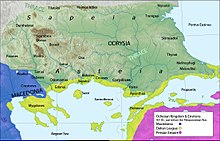Sintians
The Sintians (/ˈsɪntiənz/; Template:Lang-grc-gre), "the Raiders, the Plunderers", from Ancient Greek sinteis, "destructive"[1]) were known to the Greeks as pirates and raiders;[2] they are also referred to as a Thracian people[3] who once inhabited the area of the nowadays Sintiki province of Greece, the island of Lemnos (hence Sintêïs) is an old name for Lemnos and the southwestern corner of Bulgaria.

The Sintians worshipped Hephaestus. They are mentioned in Homer: in the Iliad[4] as the folk who had tended Hephaestus in Lemnos after the lame smith god was let fall to earth; the Sintians “of wild speech” (ἀγριόφωνοι agriophonoi) also appear in the Odyssey;[5] in the tradition reported by Homer it was understood by their incomprehensible speech that they were among the non-Hellenic peoples of the Aegean.[6] "Because the Sintians have no place in the immediate context (that is, they are not asking the god for anything), we may suspect that they were the ones who in some pre-Homeric myth rescued the god."[7] In 2002 the city of Heraclea Sintica was accidentally discovered at the foot of an extinct volcano on the land of Rupite, Bulgaria. Thus ended the years-long argument between Greece and Bulgaria about where Heraclea Sintica actually was.
References
- ^ Also Sinthi, Sintii, Synthi: Strabo gives variants of their name, x.20.17, xii.3.20.
- ^ "Warlike" to Anacreon (fr. eleg. West 3), who had spent some time in Thrace, often referenced in his poetry (Onofrio Vox, "I Sinti in Anacreonte", Hermes 122.1 (1994:116-118).
- ^ J. Wiesner, Die Thraker (Stuttgart, 1963:13ff).
- ^ 1.594 and 18.394.
- ^ 8.294 Homer, Odyssey
- ^ "Hephaistos is most at home among the Sintians of Lemnos, who do not even speak Greek," observes Guy Hedreen, in "The Return of Hephaistos, Dionysiac Processional Ritual and the Creation of a Visual Narrative", The Journal of Hellenic Studies 124 (2004:38-64) p. 39.
- ^ Bruce Karl Braswell, "Mythological Innovation in the Iliad", The Classical Quarterly, New Series, 21.1 (May, 1971:16-26) p. 20.
